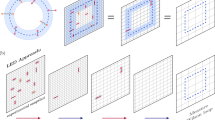Abstract
Following a suggestion of A. Kitaev, we explore the connection between fault-tolerant quantum computation and nonabelian quantum statistics in two spatial dimensions. A suitably designed spin system can support localized excitations (quasiparticles) that exhibit long-range nonabelian Aharonov-Bohm interactions. Quantum information encoded in the charges of the quasiparticles is highly resistant to decoherence, and can be reliably processed by carrying one quasiparticle around another. If information is encoded in pairs of quasiparticles, then the Aharonov-Bohm interactions can be adequate for universal fault-tolerant quantum computation.
Access this chapter
Tax calculation will be finalised at checkout
Purchases are for personal use only
Preview
Unable to display preview. Download preview PDF.
Similar content being viewed by others
References
R. P. Feynman, Simulating physics with computers, Int. J. Theor. Phys. 21, 467 (1982).
D. Deutsch, Quantum theory, the Church-Turing principle and the universal quantum computer, Proc. Roy. Soc. Lond. A 400, 96 (1985).
P. Shor, Algorithms for quantum computation: discrete logarithms and factoring, in Proceedings of the 35th Annual Symposiumoon Fundamentals of Computer Science (Los Alamitos, CA, IEEE Press, 1994), pp. 124–134.
R. Landauer, Is quantum mechanics useful? Phil. Tran. R. Soc. Lond. 353, 367 (1995).
R. Landauer, The physical nature of information, Phys. Lett. A 217, 188 (1996).
R. Landauer, Is quantum mechanically coherent computation useful? In Proc. Drexel-4 Symposium on Quantum Nonintegrability-Quantum-Classical Correspondence, Philadelphia, PA, 8 September 1994, ed. D. H. Feng and B.-L. Hu (Boston, International Press, 1997).
W. G. Unruh, Maintaining coherence in quantum computers, Phys. Rev. A 51, 992 (1995).
S. Haroche and J. M. Raimond, Quantum computing: dream or nightmare? Phys. Today 49(8), 51 (1996).
P. Shor, Scheme for reducing decoherence in quantum memory, Phys. Rev. A 52, 2493 (1995).
A. M. Steane, Error correcting codes in quantum theory, Phys. Rev. Lett. 77, 793 (1996).
A. M. Steane, Multiple particle interference and quantum error correction, Proc. Roy. Soc. Lond. A 452, 2551 (1996).
P. Shor, Fault-tolerant quantum computation, in Proceedings of the Symposium on the Foundations of Computer Science (Los Alamitos, CA: IEEE Press, online preprint quant-ph/9605011, 1996).
A. Yu. Kitaev, Quantum error correction with imperfect gates, in Quantum Communication, Computing and Measurement ed. O. Hirota, A. S. Holevo, and C. M. Caves (New York, Plenum, 1997).
D. DiVincenzo and P. Shor, Fault-tolerant error correction with efficient quantum codes. Phys. Rev. Lett. 77, 3260 (1996).
A. M. Steane, Active stabilization, quantum computation and quantum state synthesis, Phys. Rev. Lett. 78, 2252 (1997).
D. Gottesman, A theory of fault-tolerant quantum computation, Phys. Rev. A (online preprint quant-ph/9702029, 1997).
E. Knill and R. Laflamme, Concatenated quantum codes (online preprint quant-ph/9608012, 1996).
E. Knill, R. Laflamme, and W, Zurek, Accuracy threshold for quantum computation, (online preprint quant-ph/9610011, 1996).
E. Knill, R. Laflamme, and W. Zurek, Resilient quantum computation: error models and thresholds Science 279, 342 (1998).
D. Aharonov and M. Ben-Or, Fault tolerant quantum computation with constant error (online preprint quant-ph/9611025, 1996).
A. Yu. Kitaev, Quantum computing: algorithms and error correction, Russian Math. Surveys 6 (1997).
J. Preskill, Reliable quantum computers, Proc. R. Soc. Lond. A 454, 385 (1998).
C. Zalka, Threshold estimate for fault tolerant quantum computing (online preprint quant-ph/9612028, 1996).
A. Yu. Kitaev, Fault-tolerant quantum computation by anyons (online preprint quant-ph/9707021, 1997).
J. Preskill, Quantum computing: pro and con, Proc. Roy. Soc. Lond. A 454, 469(1998).
R. Prange and S. Girvin, eds., The Quantum Hall Effect (New York, Springer-Verlag, 1987).
N. Read and E. Rezayi, Quasiholes and fermionic zero modes of paired fraction quantum Hall states: the mechanism for nonabelian statistics (online preprint condmat/9609079, 1996).
C. Nayak and F. Wilczek, 2n quasihole states realize 2n-1-dimensional spinor braiding statistics in paired quantum Hall states (online preprint cond-mat/9605145, 1996).
G. ’Hooft, On the phase transition toward permanent quark confinement, Nucl. Phys. B 138, 1 (1978).
M. Alford, S. Coleman, and J. March-Russell, Disentangling nonabelian discrete quantum hair, Nucl. Phys.B 351, 735 (1991).
F. A. Bais, Flux metamorphosis, Nucl. Phys.B 170, 32 (1980).
H.-K. Lo and J. Preskill, Nonabelian vortices and nonabelian statistics, Phys. Rev. D 48, 4821 (1993)
G. Moore and N. Read, Nonabelions in the fractional quantum Hall effect, Nucl. Phys. B 360, 362 (1991).
M. G. Alford, K. Benson, S. Coleman, J. March-Russell, and F. Wilczek, Interactions and excitations of nonabelian vortices, Phys. Rev. Lett. 64, 1632 (1990).
J. Preskill and L. M. Krauss, Local discrete symmetry and quantum mechanical hair, Nucl. Phys. B 341, 50 (1990).
D. A. Barrington, Bounded width polynomial size branching programs recognize exactly those languages in NC1, J. Comp. Sys. Sci. 38, 150–164 (1989).
A. Yu. Kitaev, Quantum measurements and the abelian stabilizer problem (online preprint quant-ph/9511026, 1995).
S. W. Hawking, Breakdown of predictability in gravitational collapse, Phys. Rev. D 14, 2460 (1976).
D. Dieks, Communication by electron-paramagnetic-resonance devices. Phys. Lett. A 92, 271 (1982).
W. K. Wootters, and W. H. Zurek, A single quantum cannot be cloned, Nature 299, 802 (1982).
T. Banks, M. E. Peskin, and L. Susskind, Difficulties for the evolution of pure states into mixed states, Nucl. Phys. B 244, 125 (1984).
Author information
Authors and Affiliations
Editor information
Editors and Affiliations
Rights and permissions
Copyright information
© 1999 Springer-Verlag Berlin Heidelberg
About this paper
Cite this paper
Walter Ogburn, R., Preskill, J. (1999). Topological Quantum Computation. In: Williams, C.P. (eds) Quantum Computing and Quantum Communications. QCQC 1998. Lecture Notes in Computer Science, vol 1509. Springer, Berlin, Heidelberg. https://doi.org/10.1007/3-540-49208-9_31
Download citation
DOI: https://doi.org/10.1007/3-540-49208-9_31
Published:
Publisher Name: Springer, Berlin, Heidelberg
Print ISBN: 978-3-540-65514-5
Online ISBN: 978-3-540-49208-5
eBook Packages: Springer Book Archive




